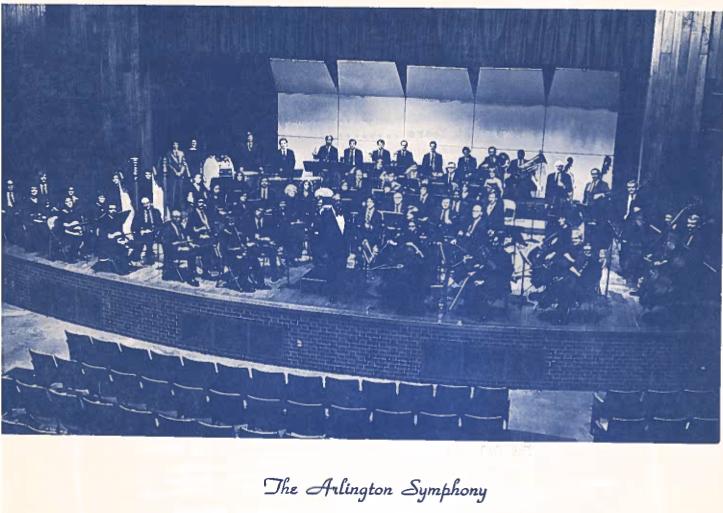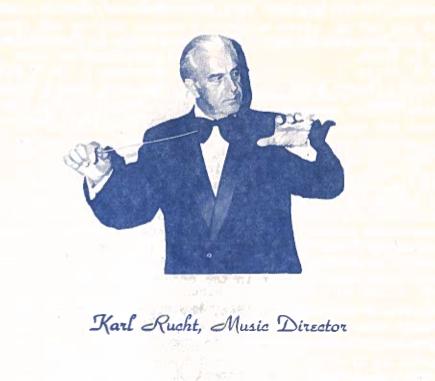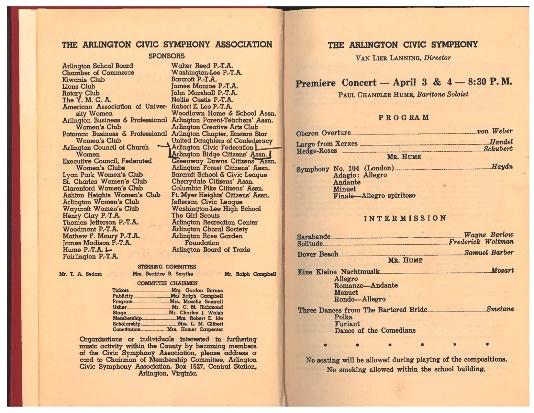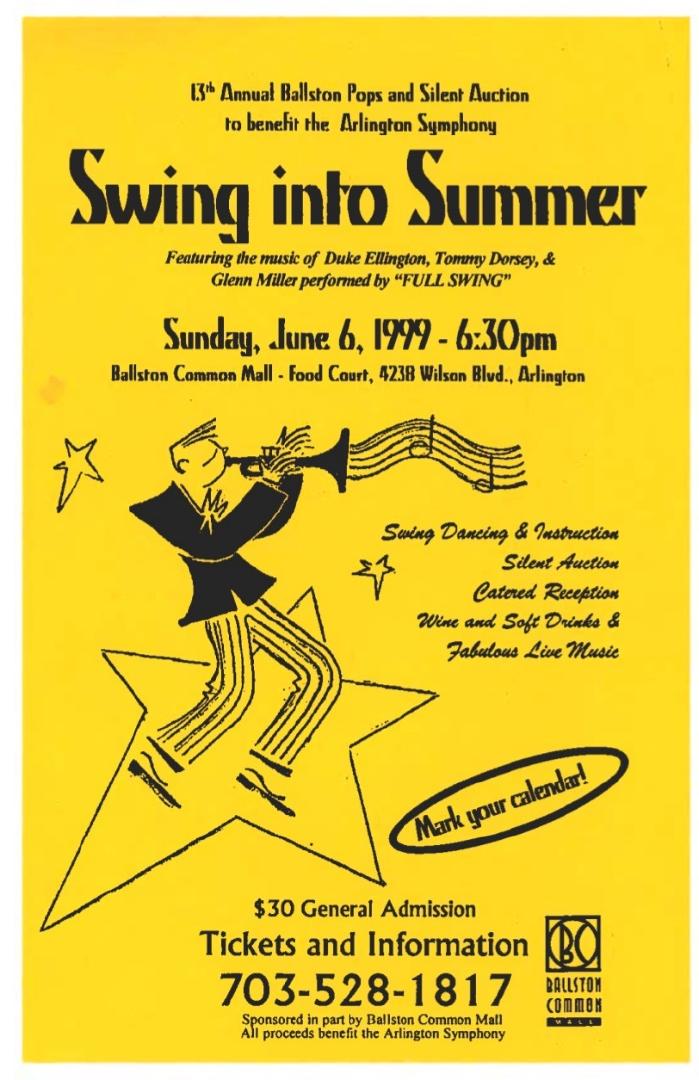Arlington Symphony

The Arlington Philharmonic is the only professional symphony orchestra in Arlington, Virginia. Its roots go back to 1946 and the original Arlington Symphony.
The Arlington Symphony was organized in the years following World War II, providing a source of respite from the turmoil of the wartime years.
Van Lier Lanning, an Arlington resident, led these initial organizing efforts. Lanning had also organized and directed the War Production Board orchestra during WWII. Lanning’s vision was to establish a suburban orchestra. This dream materialized in late 1945 as local citizens began to sign on to establish a “civic orchestra.”
A volunteer group of Arlingtonians formed a Steering Committee and recruited players, who also chipped in $10 apiece to purchase sheet music. Ellis Chasens, the former War Production Board Orchestra concertmaster, signed on as the Arlington Symphony’s first concertmaster.
The premiere concert occurred on Friday, April 3, 1946, at Washington-Lee High School (now Washington-Liberty). This opening night, they featured baritone soloist Paul Hume, who went on to serve as the Washington Post’s music critic. The evening was a resounding success, and a second performance followed the next evening. Another performance in June followed, and by the fall of 1946, plans for a complete program were underway.
A program of eight concerts was approved for the following year: four of them would be evening, adults-only concerts, and four would be Sunday afternoon children’s concerts, followed by performances of a youth orchestra. This set the pattern for the orchestra’s early schedules.
Tickets in this first program year were 75 cents for the adult concerts and 30 cents for the children’s concerts. From 1951-1968, programming was free, but tickets were reinstated in later years to accommodate for budgeting gaps.
Numerous conductors served in these early years, but the position went unoccupied by the 1954-1955 season due to insufficient funds for part-time work. Later that year, John Wigent signed on to the job. Wigent, a trained clarinetist and double bassist, had previously served as Harry Truman’s pianist and organ player at the Arlington Temple in Rosslyn. Karl Rucht signed on as the next director, where he served for more than 15 years. Rucht was known for his drama, flare, and “spectaculars” – including full concert versions of operas, exceptional soloists, and concerts with more than 300 performers on stage.
One of the Symphony’s signature elements was solo performers featured in the hundreds throughout the seasons. The soloist program was not only a chance to highlight talent but also broadened the scope of the Symphony, as it included performers from across the nation and abroad. One of the Symphony’s most famous soloists was Evelyn Swartout, who performed four consecutive years in a row.
The soloist program was also a way to incorporate younger members of the Arlington community, who were sometimes selected from the Association’s scholarship program. In the 1940s, public education in music was limited, and the Symphony filled this gap with its musical programming, even as the move toward public music courses increased in later decades.
The Symphony Association, County government, and other civic and social groups often collaborated to support the group’s artistic efforts. The School Board provided spaces for rehearsals and concerts for no or reduced fees. In 1966, members of the Association met with County Manager Bert Johnson, who provided $3,600 in funding from the County budget. This arrangement lasted for much of the symphony’s lifetime, increasing over the years due to inflation. Other fees were supplemented by Association fundraising and external grants.
The Association’s Board of Directors was incorporated in 1966 and comprised 26 to 30 members. The group was augmented and supported by a Women’s Committee for the Symphony, which comprised 114 members by 1980.
In 1980, March was designated as “Arlington Symphony Month” by the Arlington County Board.
In 1985, the Arlington Symphony celebrated its 40th anniversary. Among its members that season was Caurine Easterling, a 40-year veteran. A write-up on the event in the Washington Post notes the symphony’s range of ages—from teenagers to octogenarians—and notes that this was the final season Karl Rucht served as musical director.
The Arlington Symphony came to a close in 2005 after declaring bankruptcy. Its final music director was Ruben Vartanyan, who served with the symphony for 13 years. In 2006, a group of former Symphony members joined the Arlington Philharmonic, and Vartanyan directed the new group’s inaugural concert, leading a performance of Tchaikovsky's Serenade for Strings, Op. 48.
Arlington still hosts the Arlington Philharmonic, the Arlington Concert Band, and many other classically focused musical groups and organizations.
The mission of the Arlington Philharmonic is to make classical music accessible to every Arlington resident, to promote the value of classical music in our civic life, and to build strong, creative partnerships with schools, local government, businesses, and other organizations. We affirm that racial equity - an understanding and acknowledgment of historical and ongoing racial inequities and a commitment to actions challenging those inequities - is a core tenet of our beliefs as an organization and will be embedded in our structure, operations, and artistic endeavors.
The Arlington Philharmonic is the only professional symphony orchestra in Arlington, Virginia. The Philharmonic performs three classical concerts annually at various locations throughout Arlington, plus an outdoor concert at Lubber Run Amphitheater. The Philharmonic is unique among regional professional orchestras because it does not charge admission. This means that the excellent, live, professional music performances the Philharmonic provides are available to everyone -- at every income, every age. We also sponsor various education and outreach initiatives for all ages, including programs for students in the Arlington Public Schools for adults over 55. We also sponsor the Crescendo Chamber Music Program for middle and high school strings students.
Arlington Philharmonic concerts are supported solely by grants and donations. Although there is no charge to attend Arlington Philharmonic concerts, donations help defray the costs of the performances and are greatly appreciated.
The Philharmonic is supported in part by Arlington County through Arlington Cultural Affairs, a division of Arlington Economic Development, and the Arlington Commission for the Arts, and in part by the Commonwealth of Virginia through the Virginia Commission for the Arts and the National Endowment for the Arts.
Images



